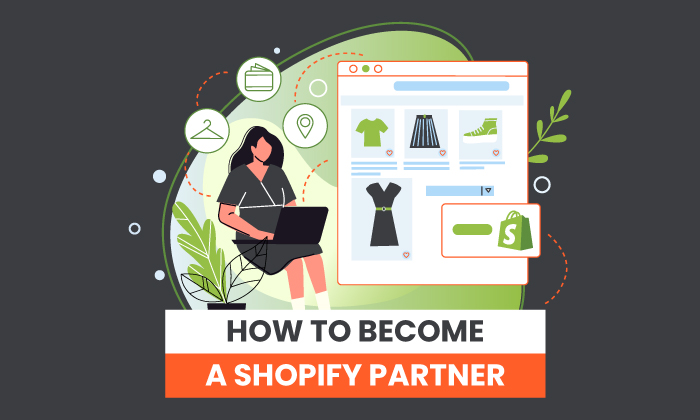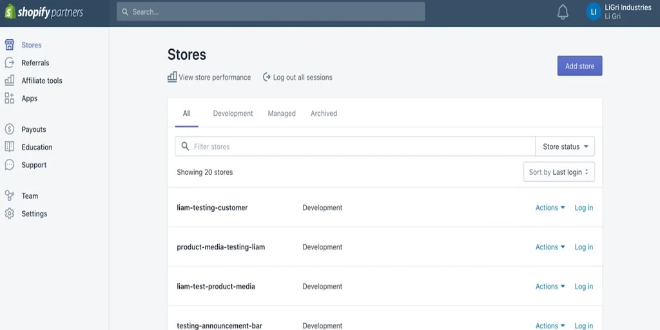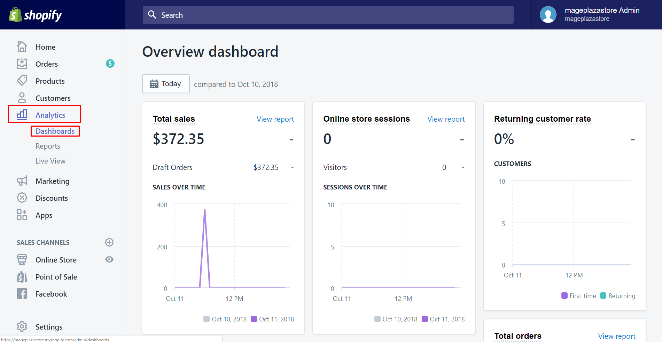
As one of the largest e-commerce platforms on the internet, Shopify offers budding (and established) entrepreneurs a platform to sell their wares and increase their reach.
In fact, Shopify dominates nearly 20 percent of the e-commerce market share.
That’s not all. With millions of active buyers on the platform, there is plenty of opportunity for brands to grow their revenue.
In addition to a massive audience, Shopify offers users a simple, streamlined experience that allows store set up in record time.
When you join the Shopify platform, you have immediate access to functionality that allows you to:
- build a website
- create a domain
- multiple payment options
- order receiving and processing
In short, Shopify equips sellers with the tools they need to get their store off the ground.
Shopify benefits don’t only apply to online vendors—through their unique partnership program, individuals can align with Shopify to grow their business and increase revenue through a variety of functions.
Is the Shopify Partner program right for you? Here’s what you need to know.
What Is the Shopify Partner Program?
The Shopify Partner Program is a set of tools and resources Shopify users can leverage to grow their business. This is done through four main categories:
- Marketing: For Shopify users in need of a more defined audience, streamlined campaigns, or optimized content, Shopify Marketers can offer their services to help Shopify users increase their reach and employ better marketing strategies.
- Shopify Developers: Experts in Shopify store development, can build apps that help Shopify’s merchants in a variety of ways, including increased engagement and sales.

- Shopify Designers: From graphics to branding, these design experts help stores with design needs, often working collaboratively with developers.
- Affiliate Marketing on Shopify: Affiliate marketers can offer nearly any service on the platform, from influencer marketing to content creation.
Shopify Partners can also build and sell Shopify apps and themes to generate income.
In addition to the above different kinds of Partners, there are also different levels of partnership, including:
- Shopify Partners: Consider this the entry-level role for Shopify Partners. At this level, you gain access to limitless test stores, allowing you to customize, learn and hone your craft. For each action (client referral, app designed, or graphic completed), you earn a monthly commission.
- Shopify Plus Partners: This tier is exclusively for Shopify Partners who do excellent work. This level often includes agencies, enterprise consultants, and system integrators, as well as individuals.
- Shopify Fulfillment Partners: Fulfillment partners make up the Shopify Fulfillment Network and can operate inside or outside of the bounds of the Shopify Partner Program.
What Are the Advantages of Becoming a Shopify Partner?
Given that one in three Shopify sellers seek services from Shopify Partners, there’s a real opportunity for you to supplement your income when you join the program. In addition to adding some extra padding to your bank account, Partners can access free training resources and perks, including:
- FAQs
- how-to articles
- live chat
- the Shopify Academy
The partnership also comes with access to an unlimited number of stores, so you can experiment to your heart’s content.
As a Shopify Partner, you gain exclusive access to offers on tools that can help you run and grow your business. Once you have your dashboard set up (more on that later), select the “Partner Perks” section and select the “Claim perk” button.
Even better, when you sign up to become a Shopify Partner, you create opportunities to scale your business. Regardless of whether you’re a well-established agency or an individual setting out to grow your skills and client base, enrolling in the Shopify Partner program is a great growth opportunity.
Sound good?
Let’s break down how you actually become a Shopify Partner.
5 Steps to Become a Shopify Partner
The Shopify partnership comes with plenty of perks we’ve already covered, but there’s one overarching benefit we haven’t covered: Becoming a Shopify Partner is free.
Now that you have a better understanding of the value associated with a Shopify Partnership, follow these five steps to start growing your business today.
1. Learn More About Shopify Partners
This blog explores the surface-level of a Shopify Partnership, however, you’ll want to spend more time on the Shopify partner page to read the blog and learn more about partner perks and features.
2. Join the Shopify Partner Program
This is the easiest step yet! Simply head to the sign-up page and enter your name and email address and wait for your verification.
3. Verify Your Email Address
After creating an account, you’ll receive an email asking you to follow a link to verify your email address. Be sure to do this within 24 hours, as the window for response closes after that timeframe.
After you select the blue button to confirm your account, you’ll land on the Shopify accounts page. From there, choose “Shopify Partners” and then “Create new partner account.”
4. Enter Your Information
Now that you’ve successfully set up an account, you must complete a form that asks for the specifics of your business. Complete all the necessary fields.
After this step, scroll down to the “Business goals” section and choose the function that best suits your offering. Here you can select:
- building apps
- building new Shopify stores for clients
- providing Services to existing Shopify merchants
- referring merchants as an affiliate
- selling products as a Shopify merchant
- other
After you’ve selected the right category, scroll down the page until you reach the section about platform usage. Here, you’ll identify which platforms you’re currently using, allowing Shopify to equip you with custom tools.
Categories include:
- BigCommerce
- Lightspeed
- Magento
- PrestaShop
- Square
- Squarespace
- Wix
- WooCommerce
- WordPress
- None
- Other
After selecting the relevant category, read the Partner Program Agreement at the bottom of the page and check the corresponding box.
5. Meet Your Shopify Dashboard
Your dashboard is the hub of your Shopify business. To get started, select the Shopify Partner programs you’d like to apply to from the “Get started” section.

A short form will ask you to explain your interest in each program.
Even if you’re not accepted into a program immediately, you can still use your dashboard to grow and hone your skills. With endless courses available from the Shopify Partner Academy, you can earn certifications in Business Fundamentals, Theme Development, App Development, and Product Fundamentals.
You can take the accompanying test as many times as you like, all while using the resources provided through the Shopify Partner Academy to increase your knowledge base.
After receiving your acceptance to one of the Shopify Programs, you can start earning some cash. Payments occur on a bi-monthly schedule via PayPal.
The Partner Dashboard is also your source for all questions. From the portal, you can contact Shopify support whenever, wherever to get your questions answered.
Measuring the Success of Your Shopify Partnership
You’ve set up your dashboard, been accepted into a few programs, have been working for a few months, and now you want to know how successful your Shopify partnership actually is.
While there are countless metrics you can use to track the success of your endeavors, here are six key figures to assess the strength and success of your partnership.
Lead Conversion Rate
This metric is exactly what it sounds like: a measurement of how many leads converted into customers in a specific period of time, generally within 30-day increments.
Significant due to its ability to highlight how successful your campaigns are at turning attraction into actual leads, your lead conversion rate is a must-track metric.
How do you calculate lead conversion rate? The formula is pretty simple, as long as you have the numbers.
Lead Conversion Rate = (Number of new customers in the last x days ÷ number of leads in the last x days) x 100
Lead Velocity Rate (LVR)
This figure is representative of real-time sales performance. Given its predictive nature, the metric is perfect for forecasting revenue growth.
How do you calculate lead velocity rate?
Lead velocity rate = (Number of qualified leads this month – number of qualified leads last month) ÷ number of qualified leads last month x 100
Monthly Recurring Revenue (MRR)
This metric represents revenue, rather than what is actually actively collected. A good indicator of success, MRR lets you know if your leads are converting to actual customers within a finite time span.
How do you calculate MRR?
MRR = Number of customers x average billed amount
Churn Rate
This metric refers to the number of customers who stop using your service during a specific time frame. Churn rate is a valuable metric to determine if your marketing strategies and onboarding process is effective.
How do you calculate churn rate? There are two types of churn rate:
User churn = (Cancelled users in the last 30 days ÷ active users 30 days ago) x 100
Revenue churn = (MRR lost to downgrades & cancellations in the last 30 days ÷ MRR 30 days ago) x 100
Average Revenue Per User (ARPU)
Use this metric to learn how much revenue you’re creating from each individual user. This statistic is valuable to assess marketing successes and failures and forecast revenue goals.
How do you calculate ARPU?
ARPU = MRR ÷ active users
Lifetime Value (LTV)
This metric represents the amount a user will spend on your service throughout the course of your relationship. This figure helps you assess whether it is more valuable to maintain existing customers or pursue new ones.
How do you calculate LTV?
LTV = Average monthly recurring revenue per customer ÷ user churn rate
I recommend monitoring these figures on a daily, weekly, and monthly basis for a comprehensive view of your success. These metrics let you identify patterns and see if improvements succeed so you can adjust your approach as needed.
Conclusion
Shopify’s continuous growth shows no signs of stopping.
For any digital marketers, developers, or graphic designers, becoming a Shopify Partner offers an opportunity to broaden your portfolio, sharpen your skills, and earn some extra cash.
If you’re looking to increase your client base and your revenue, Shopify might be the place for you.
If you’re considering wading into the world of Shopify partnership, be sure to actively monitor the right metrics and ignore vanity metrics that have little impact on overall success.
What part of the Shopify Partner program is most useful to you?
from Blog – Neil Patel https://ift.tt/3t9nyEp

No comments:
Post a Comment